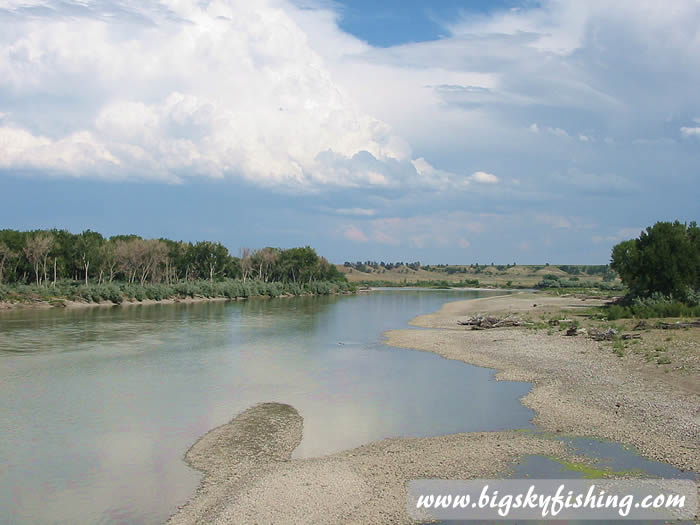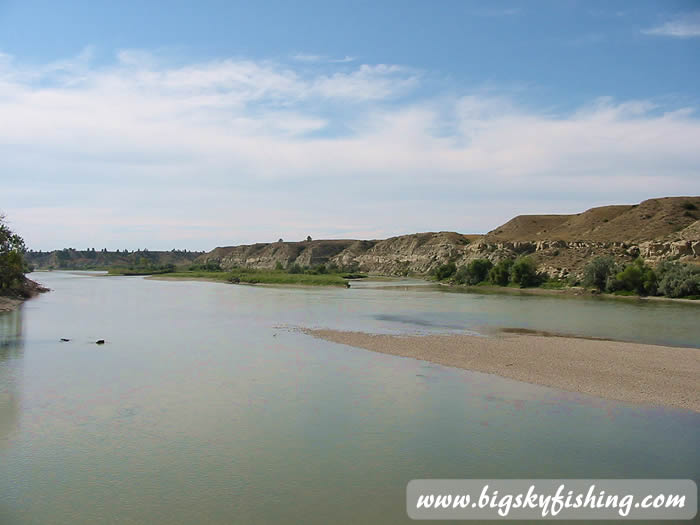The Lower Yellowstone River, which runs from Billings to the North Dakota border, is an attractive beauty. While it lacks the crowning peaks flanking its banks as is found further upstream, the cliffs along the river, the cottonwood trees and the sweep of the prairie all create a beautiful scene. And in the fall, as the colors turn on the hardwood trees along the river, the Yellowstone River in eastern Montana becomes truly a beautiful sight.
 |
| Lower Yellowstone River |
Other than an occasional odd brown trout that might be found just below Billings and then again at the confluence with the Bighorn River, trout will not be found in the lower Yellowstone River. It is a warm water fishery, holding scores of large catfish, pike, walleye and smallmouth bass. While the smallmouth bass can be fished adequately with a fly rod, using weighted crayfish on sinking lines, spin fishing is the rule on the Lower Yellowstone River.
The Yellowstone River is very big river downstream from Billings, even in late summer when the flows taper off. It is also deep and has a surprisingly steady current even well out into the prairie. As a result, wade fishing, except at the lowest of water during late summer, is very restricted. Instead, float fishing from a raft, a high powered jet boats or simply a row boat with a powerful motor are the prime method to fish the waters of the Lower Yellowstone.
The Lower Yellowstone River receives light fishing pressure, but it does receive a low to moderate amount of use by recreational users. Still, the Lower Yellowstone is hardly overrun with boaters, and a floater has a good chance of having a sizable portion of the river to themselves on a float trip.
Access to the Lower Yellowstone River is very good. Many designated fishing access sites exist, and most bridge crossings of the river have either a small park or unofficial boat ramp, allowing for many places to put-in and take-out.
 |
| Rocky Cliffs |
Due to the fast current of the Yellowstone River and the potential for high winds, a float tube may not be the best "vessel". Instead, use either a large or small inflatable raft, inflatable kayak or a motorboat which has a strong enough motor to fight the current. Anglers using a motorboat need to beware of the many gravel bars in the river, as they are found everywhere once the river levels drop following spring run-off.
A float trip on the Lower Yellowstone River can be a very long one. Other than a handful of diversion dams, the Yellowstone River is free of all obstacles from Billings to the North Dakota border. Since this is more than 300 miles, an epic length float trip is possible. Best of all, since the current flows at a fairly steady pace, a floater should be able to make good time provided the winds are not too high or the current is too low due to drought or being too late in the season.
River Miles
Listed below are selected river mile points on the Lower Yellowstone River between Billings and the North Dakota border. Please visit the Yellowstone River floating page for river miles of the Yellowstone River above Billings.
- Billings : 344
- Captain Clark FAS : 310.6
- Amelia Island Fishing Access Site (Hysham): 258
- Forsyth : 220
- Pirogue Island State Park : 179.9
- Miles City : 167
- Powder River Access Site : 135
- Glendive Bridge : 79
- Elk Island Recreation Area : 51.7
- Seven Sisters Recreation Area : 39.5
- North Dakota Border : 0
